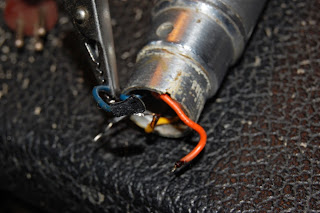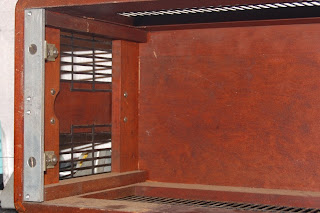It began with a feeling of dissatisfaction with my over all sound quality whenever I packed up some gear to play a live show. At this point, it's probably best if I expand on what I mean by quality: it's not a term that I am using to describe low noise, astronomical bandwidth, and remarkably low distortion figures. I have enough of that shit with the mass produced junk that birthed these complaints to begin with.
I should also point out, to the internet traveller that may be reading this as result of information hunter/gatherer forays (as opposed to the handful of freaks that know me), that in my application of these tools I am not striving for faithful reproduction, vintage tone or many other aspects in the array of audio qualities that drive gear obsessed frenzies of human endeavour. What follows is decidedly NOT a page to follow if you are hoping to recreate a nuance to fit into useful applications of gear in a client based environment, or where there may be a self professed audiophile or two creeping around the woodwork. There is no deeply entrenched philosophy driving this beyond my trying to use only what I had on hand
I also realize that from an electrical engineer standpoint the following may constitute a load of bollocks the likes of which all upstanding individuals in the industry have been striving to wrench into non-existence for about as many decades as mathematics have been applied to the craft, which, unless I am mistaken - is all of them. I realize my methods herein are laughable, and I assure anyone that were I not building this for myself I would not opt in on the sort of short cut that might make you cringe. Unless of course I was directed to do so.
So yeah, that preamble amounts to a wordy "yeah, yeah, yeah, I know" to the quantity of errors that I know follows, and furthermore to the quantity I didn't catch. Enjoy.
With the Autogram AC-8 that fronts my studio as a reference to the sound quality that got me spoiled to begin with, I decided to emulate the largely passive transformer coupled mixing network feeding discrete operational amplifiers. So this build will play out like a mystery, start at the end and work my way back. I selected the Jensen 918 as the platform I would build from, mainly because it was the first one I happened across that contained a sufficient amount of documentation.
Clearly depicted here is a complete disregard for thermal coupling, though I did strive to keep signal flow as "direct path" as I was able.
Of course, without supporting circuitry, the op-amp was somewhat underwhelming. Thankfully the documentation linked above addresses everything you need to build it Note, if you want to use a +/- 24 volt supply - you'll see reference to some value juggling on a page that doesn't seem to exist. I've had no trouble running mine on +/- 24 volts having swapped out the 27K with 47K.

I wound up slapping blocking caps on input and output because either I built it wrong, or it is designed to supply +22 volts on output, and +10 on input. If I built it wrong, I don't want to be right. Coupling caps sorted out the DC element out of respect for neighbouring stages, and the output leg with the larger carbon comp 33 ohm load is slated to feed a pair of output transformers (with 2N3904/6 complimentary pair, yes, I realize heavier outputs would do more lifting.. performs just fine for my application. Distortion capability on this board is delightful, I trimmed it up to the point at which it was clearly going into class C, then scientifically dialed it back to the point at which the audio filled out.

So, haphazard summing section in hand, I needed to sort my inputs. The aforementioned Autogram is a stereo in/out desk, and as such I have been somewhat hindered in the ability to pan mono signals without the introduction of another mixer - which paves the way back to sentence one.
GOTO 10
I don't really recall even giving the idea of a passive front end with pan any thought at all. So, right out of the gate it had to be active, and in line with my build so far it had to be devoid of integrated circuits. Enter the schematic for a Neve BA284, I worked up a layout that could fit eight onto a single proto-board.
I knew it was going to be tight, so everything went on in upright configuration..
..and when I was squeezed off the front, I resorted to stuffing from the back.
Everything is still pretty reasonable and accessible, though I am going to have to tie wires into the floating pigtails in the middle section.
Same level of progress, just another angle to illustrate my complete disregard for long lead insulation.
A moment contemplating the two, wondering what I've gotten myself into.
Who needs modern compact electrolytics when big fat dipped tantalums are on hand? Wanna argue capacitor merits? I already know the tantalum is WIDELY poo-pooed by the golden ear community (GOTO 20). Again, my build, besides, I've heard other audio egg heads remark that early Neve sound comes partly from the use of tantalum, and that his application of them biased the capacitor such that many of the distortion characteristics that many find distasteful were designed out.
Whatever, I'm regurgitating stuff I've read on the internet. I don't know. Hell, I don't even know if the schematic I used is in fact a Neve as it is passed as. Could be a heat control for a toaster oven for all I know. The big orange caps are pretty, justification complete.
Gee, maybe I should have tested this thing before going this far?
Re-work will not be a breeze.
So, once wired up for test here's what happened: Channel 1-3 passed audio, 4 was dead (bad mid 1973 tant cap on input - replaced) 5-6 passed audio, 7 was dead (solder bridge, easy fix) and 8 was very low volume (less critical solder bridge).
On to connecting the two. Currently the 8 channel block feeds 1:1 transformers, which feed a single pot passive pan control which feeds a dual gang audio taper volume control feeding the stereo buss to 918 opamps.
More blatant disregard for insulation.
HANGING FREE, READY TO SHORT.
Input block in, those ugly holes will be direct outs from the inverting output section built into the BA284 clones (hahaha, they are as much a clone of the BA284 as Frankenstein's creature is a clone of a human being, but I digress). Fun fact, the jack connected to the blue wire is an open frame TT connector, it provided me with a little more first hand experience in reworking this free form construction. A lot easier than I had expected.
Wire tie in about to be squished, then soldered.
Of course, at this point I'm working against the fact that I've got a show later in the day, and I would really like to use this thing. Top shell, current function largely wired.
Baseplate, same.
Quick connects and screw terminals allow for ease of disassembly.
It worked fine. Only the fundamental functions are installed right now, but everything goes together like legos and inserting future sections will not require anything too extreme. Current duration of work so far: July 3-19.




















































